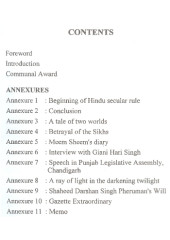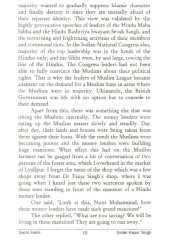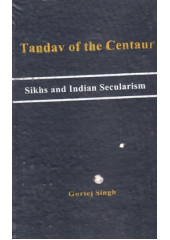Table Of Contents For 'The True Story - The State Of The Sikhs Before And After Partition' By Sirdar Kapur Singh
| |
CONTENTS
|
Page No |
| |
Foreword |
|
| |
Introduction |
|
| |
Communal Award |
|
| |
ANNEXURES |
|
| Annexure 1 |
: Beginning of Hindu secular rule |
1 |
| Annexure 2 |
: Conclusion |
2 |
| Annexure 3 |
: A tale of two worlds |
3 |
| Annexure 4 |
: Betrayal of the Sikhs |
4 |
| Annexure 5 |
: Meem Sheem's diary |
5 |
| Annexure 6 |
: Interview with Giani Hari Singh |
6 |
| Annexure 7 |
:Speech in Punjab Legislative Assembly, Chandigarh |
7 |
| Annexure 8 |
:A ray of light in the darkening twilight |
8 |
| Annexure 9 |
:Shaheed Darshan Singh Pheruman's Will |
9 |
| Annexure 10 |
:Gazette Extraordinary |
10 |
| Annexure 11 |
:Memo |
11 |
Foreword To Book 'The True Story - The State Of The Sikhs Before And After Partition' By Sirdar Kapur Singh
Sirdar Kapur Singh, initially, wrote this article "Communal Award" of Sachi Sakhi on my request in 1962, to be included in the 'Bhai Jodh Singh Memorial Volume'. But its size was ten times bigger than what we had expected, so it could not be published in it. publication however, this was a valuable article. For one, it has covered many historical events in great detail, which had not appeared as eye-witness accounts in any publication prior to this, and secondaly, the dust, settled on it because of the political propaganda, had been cleared by the time Sachi Sakhi came up and it got an opportunity to come to light. Therefore, it was decided to publish this article as a separate book which has been completed now after ten years.
This narrative is not only the story of the Communal Award made by the British Government to solve the political problem of India, but also throws light on the background of the tension between the various religious sects of India and their different demands. It also hints at the fire of hatred spread by a fanatic sect of Muslims against non-Muslims in North India, which was the main cause behind the string of sacrifices from Guru Arjan Dev ji to Guru Gobind Singh and his four sons, which later became the foundation of the political struggles between the Sikhs and the Muslims.
On the other hand, the Hindus who lived under the illusion of their superiority were full of hatred for the Muslims and had no good will for them, which led to extreme distrust of each other and it was impossible for them to co-exist. Muslims believed that the Hindu majority wanted to gradually suppress Islamic character and finally destroy it since they are mortally afraid of their separate identity. This view was validated by the highly provocative speeches of leaders of the Hindu Maha Sabha and the Hindu Rashtriya Swayam Sevak Singh, and the terrorising and frightening activities of their members and communal riots. In the Indian National Congress also, majority of the top leadership was in the hands of the Hindus only, and the Sikhs were, by and large, towing the line of the Hindus. The Congress leaders had not been able to fully convince the Muslims about their political rights. That is why the leaders of Muslim League became adamant on the demand for a muslim State in areas where the Muslims were in majority. Ultimately, the British Government was left with no option but no concede to their demand.
Apart from this, there was something else that was irking the Muslims internally. The money lenders were eating up the Muslims masses slowly and steadily. Day after day, their lands and houses were being taken from them against their loans. With the result the Muslims were becoming poorer and the money lenders were building huge mansions. What effect this had on the Muslim farmers and can be gauged from a bit of conversation of two persons of the forest area, which I overheared in the market of Lyallpur. I forget the name of the shop which was a few shops away from Dr Fauja Singh's shop, where I was going when I heared just these two sentences spoken by these men standing in front of the mansion of a Hindu money lender.
One said, "Look at this, Noor Muhammad, how these money lenders have made such grand mansions!" The other replied, " What are u saying? We will be living in these mansions! They are going to run away." It is possible that they may have heared the Muslim lawyers talking about such matters or they had put two and two together or they may have heared speeches made by the League student leaders from the ramparts of the Islamia College and Government College Lahore.
The thought of organising Punjab, the border areas and Baluchistan into an Islamic State had first been presented to the Muslim League by Dr Sir Muhammad Iqbal in 1930 in his presidential speech, which was adopted by the Muslim League and the Majority of Muslims as a definite goal, and the Qaid-e-Azam. Muhammad Ali Jinnah had made it his life's crusade and remained determined about till the end, and finally Succeeded in getting it.
Before the Communal Award, in 1928, while describing the demonstrations held at the time of the Simon Commission's arrival in Lahore, Sirdar Kapur Singh has written eye-witness accounts. He has stated it very clearly that on the 31st October, 1928, the allegation that during the lathicharge, Mr Scot hit Lala Lajpat Rai is wrong. He was not even present on the scene, and was standing far away at the Railway Station. It was the DIG Police, Mr Hamilton Hardinge, who had a cane stick in his hand, which he had swirled in the air and it had hit the umbrella held our Lala Lajpat Rai's head. No policeman so much as even lifted a stick (lathi). But this was blown out of proportion and was called a lathi charge, and Lala Lajpat Rai's death was said to have been caused by the lathis of the police. Actually, Lala Lajpat Rai died of cardiac arrest on the 17th November.
It will not be inappropriate to mention here that many a times the British were blamed for no fault of theirs. Thinking coolly and dispassionately, one has to admit the truth that the British are tempermanentally not oppressive and nor are they liars, sly and deceitful. At the personal level, the British are more honest, straightforward and trustworthy than many other communities of the world. But, because Mr Scot was incharge of the police on 31st October at the time of the procession, so there was intense propaganda against him. Then, Sardar Bhagat Singh on his companion mistook Mr Sanders for Mr Scot and killed him. It is commonly believed that Mr Sanders died beccause of the companion's shoot but Bhagat Singh took the blame on himself and was changed to death. Bhagat Singh regretted that he could not take amrit before dying, which was his last wish as he had expressed it to Bhai Randhir Singh who was to be released from the Lahore Jail soon.
From The Back Cover of 'The True Story - The State Of The Sikhs Before And After Partition' By Sirdar Kapur Singh
Sachi Sakhi by Sirdar Kapur Singh is a fascinating book that throws light or pre-partition events that have been successfully brushed under the carpet after India gained independence. In the autobiographical note, he describes the long drawn legal battle he fought against the injustice done to him by dismissing him from the prestigious post he held as an ICS officer in the early post - independence days.
It is a sad commentary on the multiple opportunities lost by the Sikhs because of their short sighted, jealous and gullible leaders. According to Sirdar Kapur Singh, in the year preceding the partition of India, the Muslims wooed the Sikhs to press for an autonomous state and promised to give one, if they would align to them. The British were keen to grant the Sikhs a respectable status so that they too could breathe the air of freedom , But the Sikh leaders failed to rise to the occasion due to infighting and petty considerations.
About The Author of 'The True Story - The State Of The Sikhs Before And After Partition'
The narrative is not only the story of the Communal Award made by the British Government to solve the political problem of India, but also throws light on the background of the tension between the various religious sects of India and their different demands. It also hints at the fire of hatred spread by a fanatic sect of Muslims against non-Muslims in north Indiia, which was the main cause behind the string of sacrifices from Guru Arjan Dev ji to Guru Gobind Singh and his four sons, which later became the foundation of the political struggles between the Sikhs and the Muslims.












